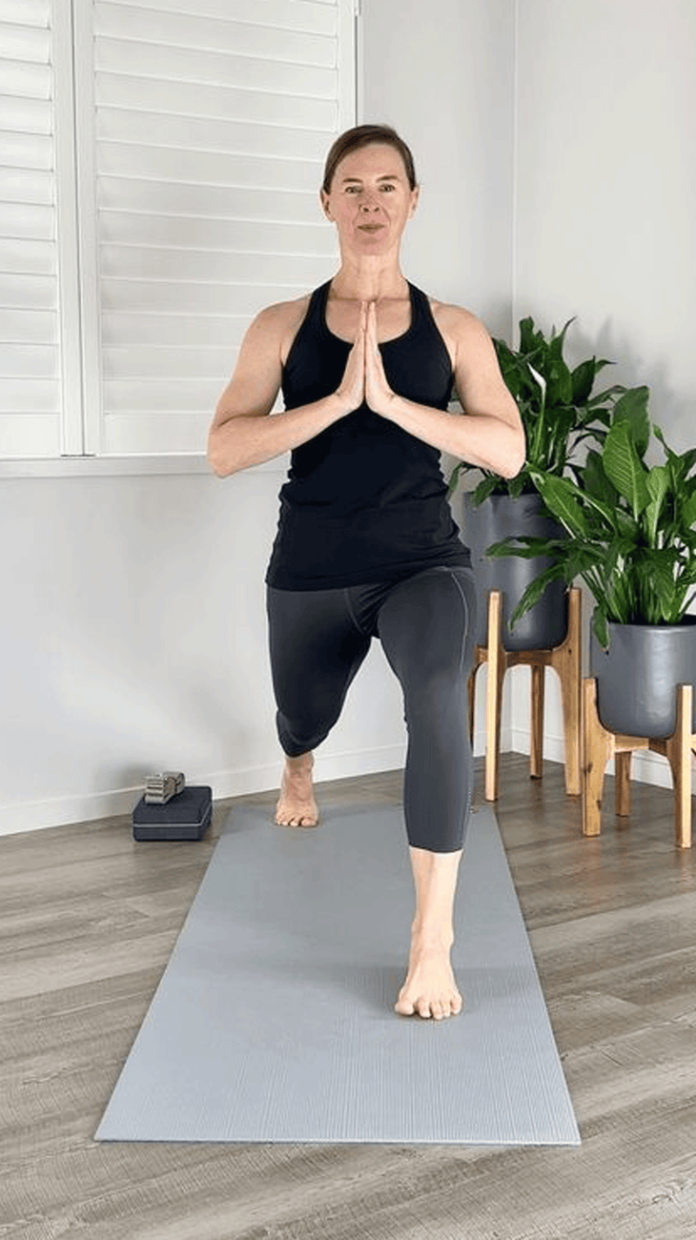“], “filter”: { “nextExceptions”: “img, blockquote, div”, “nextContainsExceptions”: “img, blockquote, a.btn, a.o-button”} }”>
Heading out the door? Read this article on the new Outside+ app available now on iOS devices for members!
>”,”name”:”in-content-cta”,”type”:”link”}}”>Download the app.
You’ve practiced High Lunge enough times that you know the shape inside and out.
But with familiarity comes, perhaps, too much comfort. It becomes easy to forget why High Lunge is a foundational component of most yoga practices.
The posture builds the type of strength required in the feet, ankles, and legs in standing poses such as Warrior 1 (Virabhadrasana I) and tiptoe poses such as Goddess (Utkata Konasana). It enhances balance and stability to prep you for standing balance poses such as Warrior 3 (Virabhadrasana III). It stretches the hip flexors on your back leg to help you feel more comfortable in almost any other pose. It creates space in your shoulder for deeper backbends such as Wheel (Urdhva Dhanurasana). And it provides practice for poses that combine several of these characteristics, such as the standing balancing backbend known as Dancer Pose (Natarajasana).
It’s versatility and utility don’t end there. Exploring slight variations on the classic alignment can make it even more essential to your practice. When you vary the basic shape even slightly, it can help prepare you for almost any pose in yoga. Here’s how.
14 High Lunge Variations You’ve Probably Never Seen Before
Even subtle adjustments to the traditional High Lunge can bring pretty profound results in terms of strengthening, stretching, and preparing you for other poses. Whether you’re a student or teacher, try incorporating these into your practice. And teachers, there are some useful insights regarding how these variations can help you prep students for challenge poses.
High Lunge Variations for Arms & Shoulders
The most approachable way to introduce variety in High Lunge is in your upper body.
1. Prayer Hands
One way to bypass shoulder pain when you take your arms overhead is, well, to stop taking your arms overhead. Instead, press your palms together at your chest in prayer hands. This action activates the chest and core muscles, making it helpful to prep you for the strength required by poses such as Plank.

2. and 3. Cactus and T Arms
So many of us spend hours of our days in shapes that are the exact opposite of the open and expansive chest required by so many backbends. Taking cactus arms (elbows bent) or T arms (elbows straight) activates your posterior shoulders and upper back, a potent counter to poor posture.
If you focus on squeezing your shoulder blades back, the pose becomes a useful preparation for Wild Thing (Camatkarasana). If you draw your attention to rotating your upper arms toward the back body, then you’re practicing an essential movement that applies to Side Plank (Vasisthasana).

4. Clasped Hands
Taking your hands behind your body, just as you would in Humble Warrior, is a different option to open your chest, create space for your breath, and prep your shoulders and upper back for backbends such as Bow (Dhanurasana), Camel (Ustrasana), and Dancer Pose.
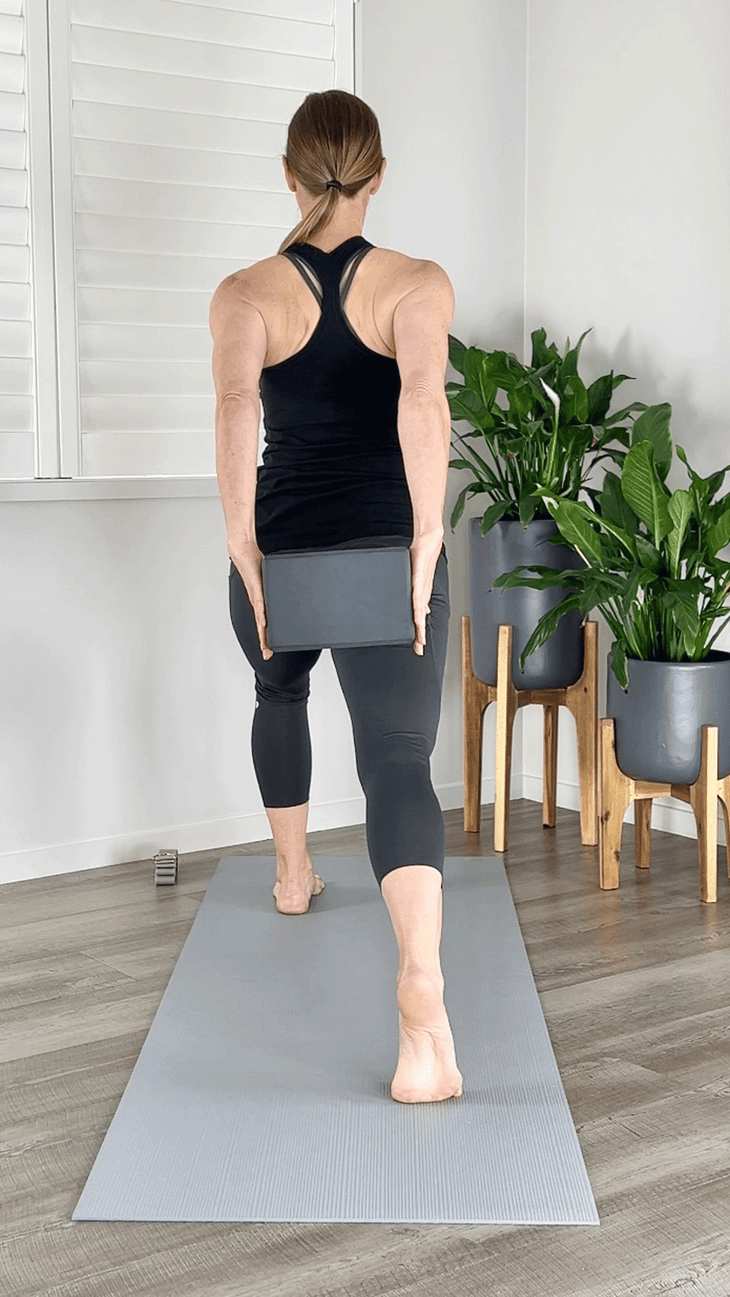
To boost the posterior shoulder and arm muscle engagement, make that same action even more active by squeezing a block between your hands. If you don’t have a block, hold a strap or belt between your hands, keeping it loose rather than letting it pull taut to highlight the backward squeeze of your shoulder blades.
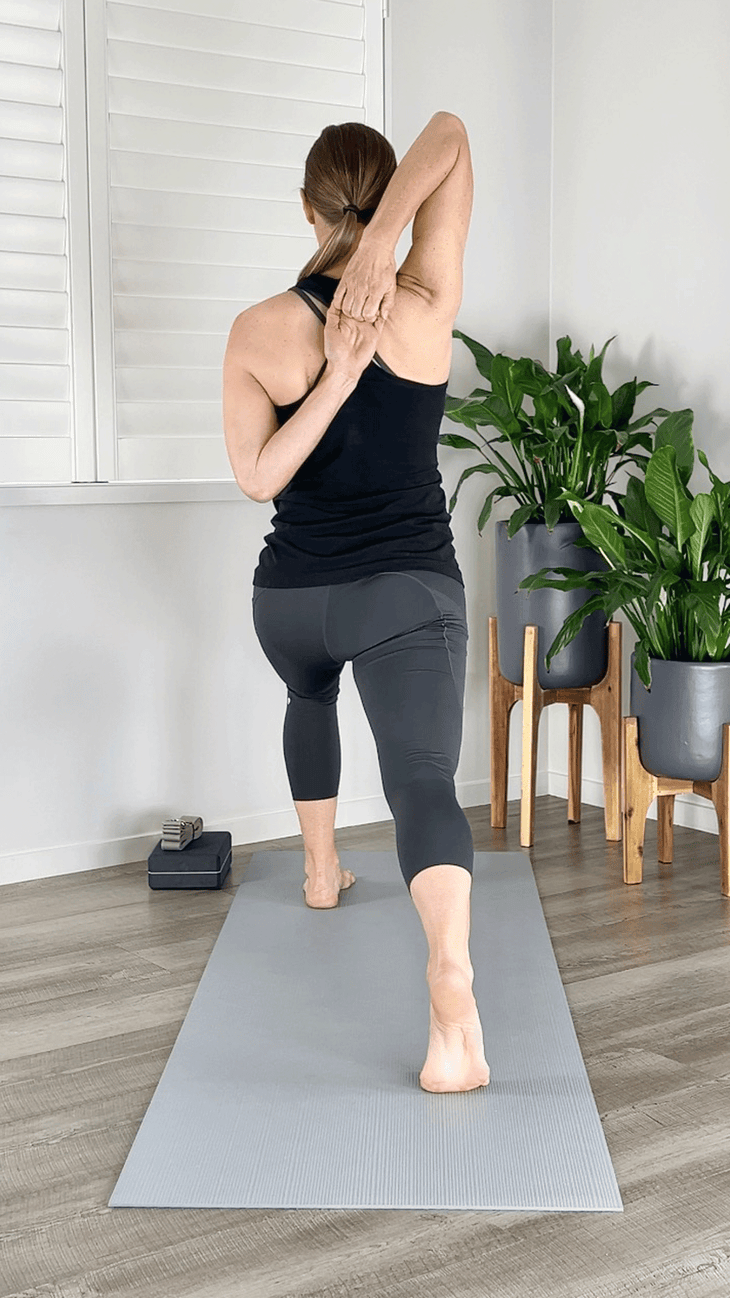
5. Cow Face Arms
The arms from Cow Face Pose (Gomukhasana) are a rarity among yoga poses in that they stretch almost all your shoulder muscles—your triceps, lats, pecs, and anterior and posterior deltoids. This variation, which can also be practiced with a strap to bridge the gap between your hands, is a much-needed tonic for the tight shoulders of everyone from athletes to desk workers.
Also, holding this arm position actively (using muscle strength alone rather than the assistance of a bind or strap) is a great way to strengthen these muscles in their lengthened positions, even if your hands don’t touch. This can be useful warm up for poses that require an arm or arms reaching overhead, including the bind in Dancer Pose, Dolphin (Ardha Pincha Mayurasana), Forearm Stand (Pincha Mayurasana), or Headstand (Sirsasana).
High Lunge Variations for Core & Spine
Explore even more potential in High Lunge by experimenting with the position and orientation of your upper body.
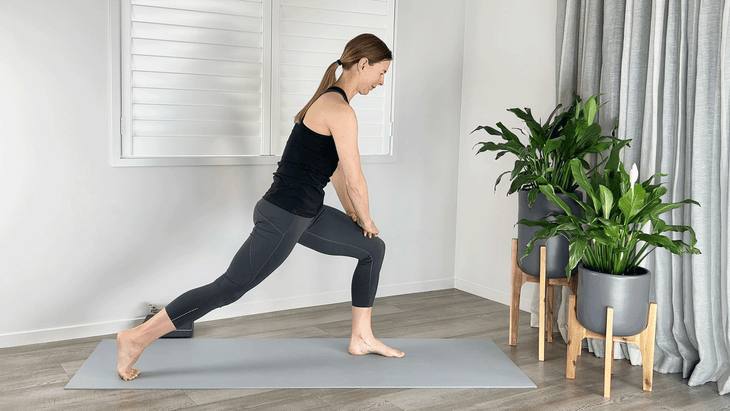
6. Cat-Cow Pelvic Tilts
Bringing the same action of Cat and Cow to your High Lunge helps warm up tense hip flexors. Tipping your frontal hip points toward your thigh is helpful rehearsal for the pelvic position of forward folds, while lengthening your sacrum toward the back of your knees is preparation for the pelvic position required by backbends.
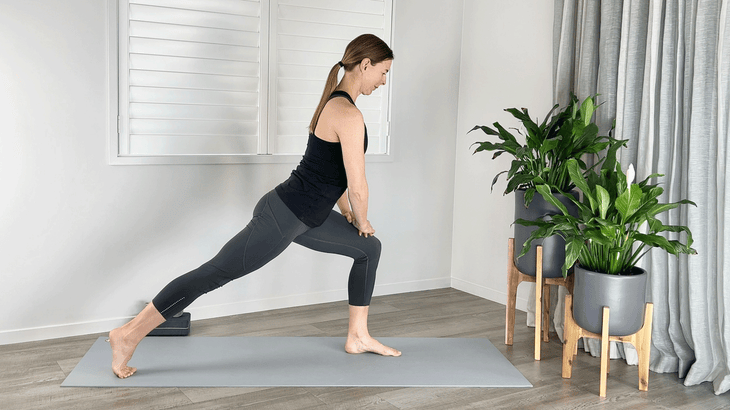
Also, discerning the midpoint between these two positions can also help you start to become aware of, and potentially undo, entrenched postural patterns.

7. Side Lunge
Taking a side bend with an overhead arm reach in High Lunge lengthens the oft-neglected side-body muscles, including your lats, triceps, quadratus lumborum, and oblique abdominals. Leaning to one side with your opposite hand on your hip stretches and prepares you for deeper side bends, such as Gate Pose (Parighasana), Revolved Head-to-Knee (Parivrtta Janu Sirsasana), even Compass Pose (Parivrtta Surya Yantrasana).
Changing things up by bringing your opposite hand to your heart asks these muscles to engage in their lengthened state, actions that are helpful when you take a standing side bend in Mountain Pose (Tadasana) or come into Extended Triangle (Utthita Trikonasana) or Side Plank. Depending on how far you lean, you can also shift your center of gravity enough to create a subtle challenge to your stability in preparation for standing balance poses.
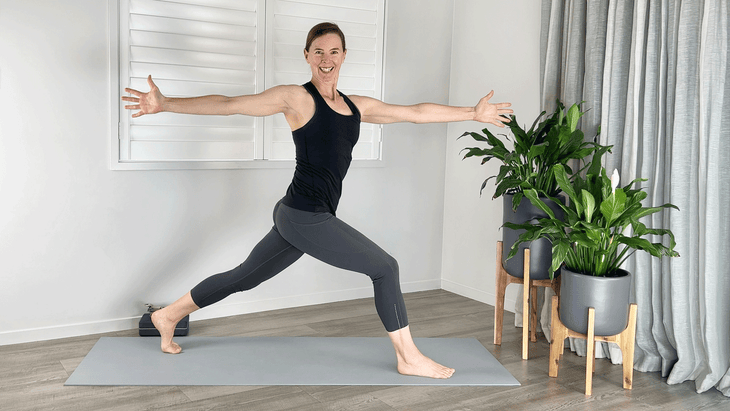
8. Twist
An active twist in which you remain upright, rather than leaning forward and relying on the leverage of your opposite elbow hooked outside of the front knee) challenges your core muscles, including the lesser-used stabilizing muscles that support the core. It also creates the foundation for deeper twists such as Revolved Triangle (Parivrtta Trikonasana) or Revolved Half Moon (Parivrtta Ardha Chandrasana) as well as bound twists including the seated Half Lord of the Fishes (Ardha Matsyendrasana).
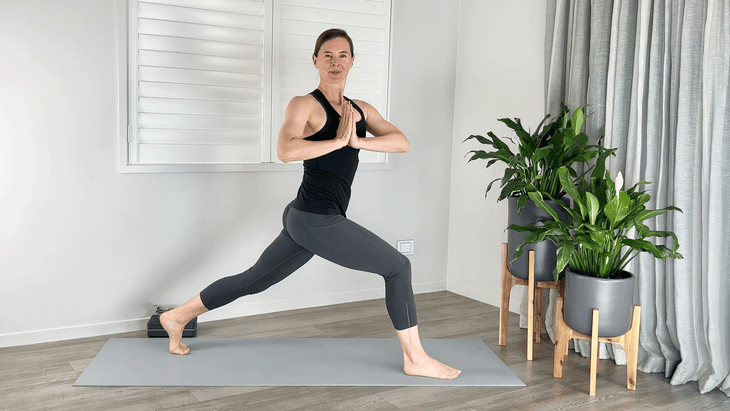
You can practice the twist with straight arms or prayer hands.
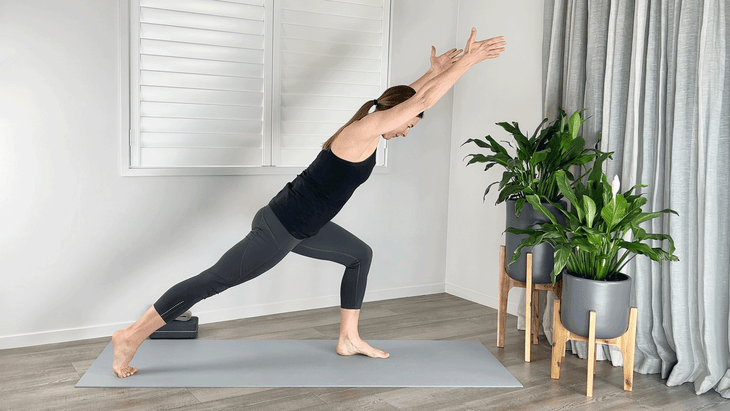
9. Leaning Forward
Leaning your torso forward in High Lunge so your body and back leg create a straight line builds much-needed back-body strength. It also allows you to practice the alignment required as you stand and balance in Warrior 3 from the more stable position of keeping both feet on the floor.
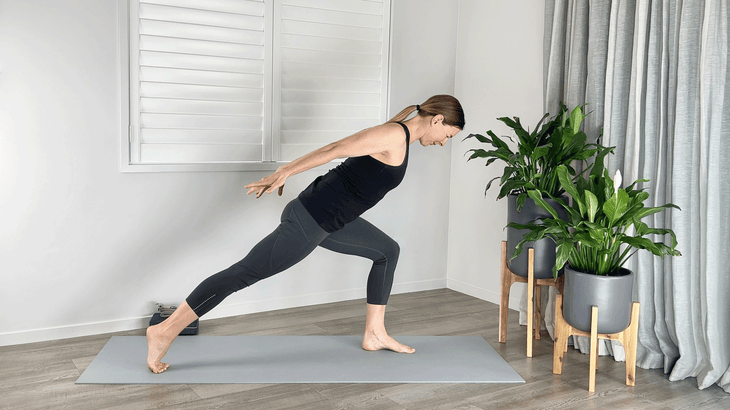
This variation, sometimes called Arrowhead, is a powerful counter to hunched posture. It can be practiced with arms alongside your head or sweeping back alongside your thighs.
Work Your Feet & Legs
With subtle adjustments, you can amplify the work High Lunge demands of your front quads, glutes, and back hip flexors, feet, and ankles.
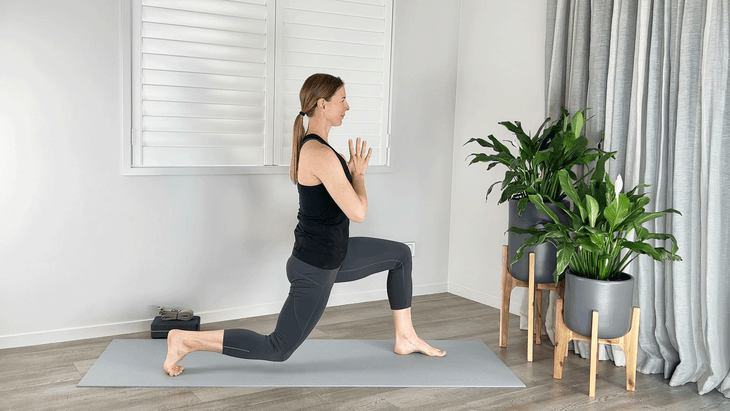
10. Deep Lunge
Bending your back knee approximately 90 degrees so it hovers just above the mat adds significantly to the quad work of High Lunge and to the stability challenge of the pose.
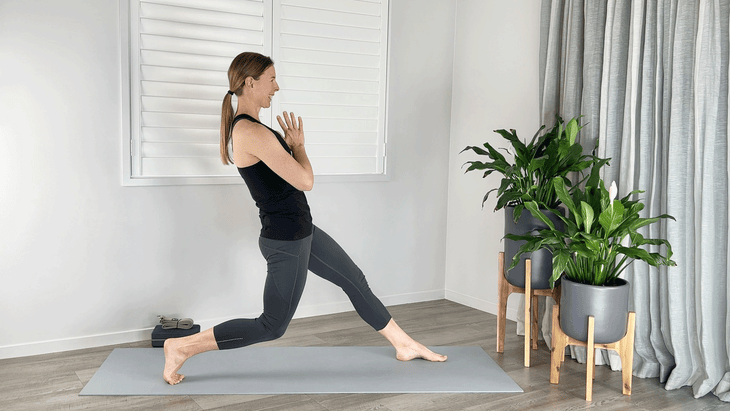
You can shift even more weight into your easily forgotten back leg by straightening your front leg and tilting your torso backward. The eccentric challenge to the quads—meaning the muscles engaging while lengthened—builds exactly the strength that you need for walking, hiking, or running downhill or downstairs without knee pain. It’s also vital on the yoga mat in Bow, Dancer, and Wheel Pose.

11. Pointed Back Foot
Pointing your back foot so the tops of your toes touch the mat builds eccentric strength in the front of your lower leg and ankle. This foot position helps train the body for Upward-Facing Dog (Urdhva Mukha Svanasana).
Challenge Your Balance
When you feel strong and stable in High Lunge, you can progressively increase the challenge to your stability, whether in preparation for one-legged standing poses or transitions or simply to enhance balance in everyday life.
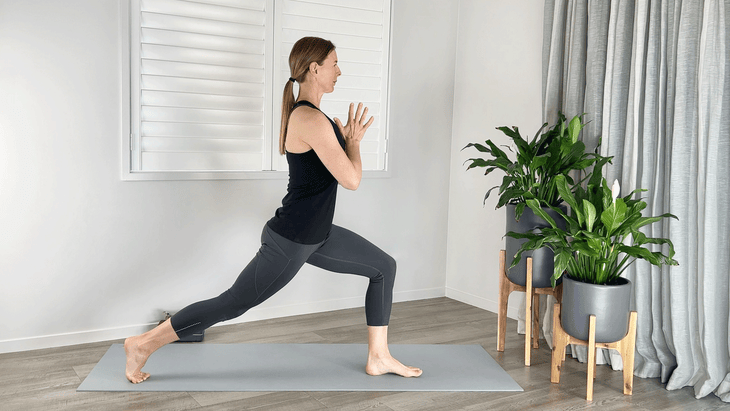
12. Tightrope Stance
Heel-toe your front foot directly in front of your back foot. This challenges your side-to-side balance more than if your feet were hip-distance apart. This can be useful training for any type of less-stable positions in yoga and in everyday life.
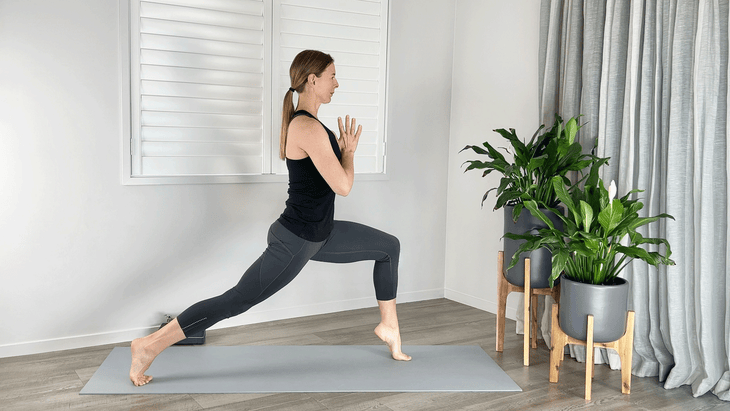
13. Tiptoes
Lift your front foot onto tiptoes or stand on a foam block to up the ante on your balance even more. You could also tuck a second block beneath your back foot to increase the challenge even more.

14. Close Your Eyes
Finally, in any of the variations described above, try moving your head or closing your eyes. This decreases your sense of stability and forces you to rely less on your drishti (gaze) for balance and challenges your sense of proprioception instead. You may find it easier to balance with prayer hands rather than arms alongside your ears.
It’s easy to overlook the potency of the familiar. But just as taking a staycation or showing friends around your hometown changes your perception of your surroundings, playing with your alignment in high lunge can give you an entirely new appreciation of this foundational shape. With any of these few tweaks, it merits a place in your practice, no matter what you are working on or toward.


